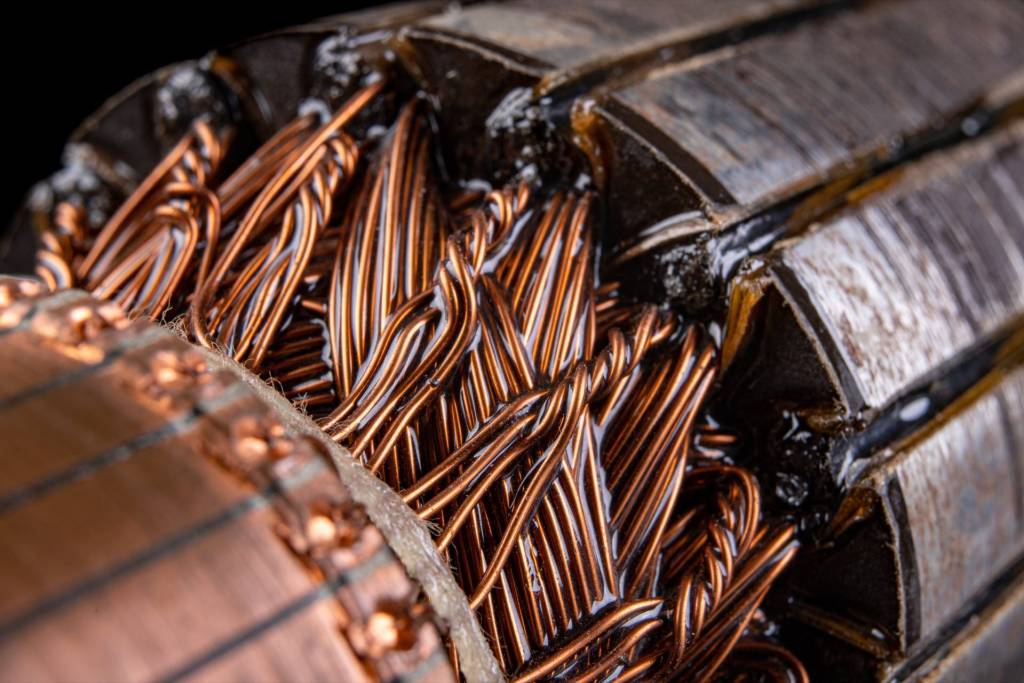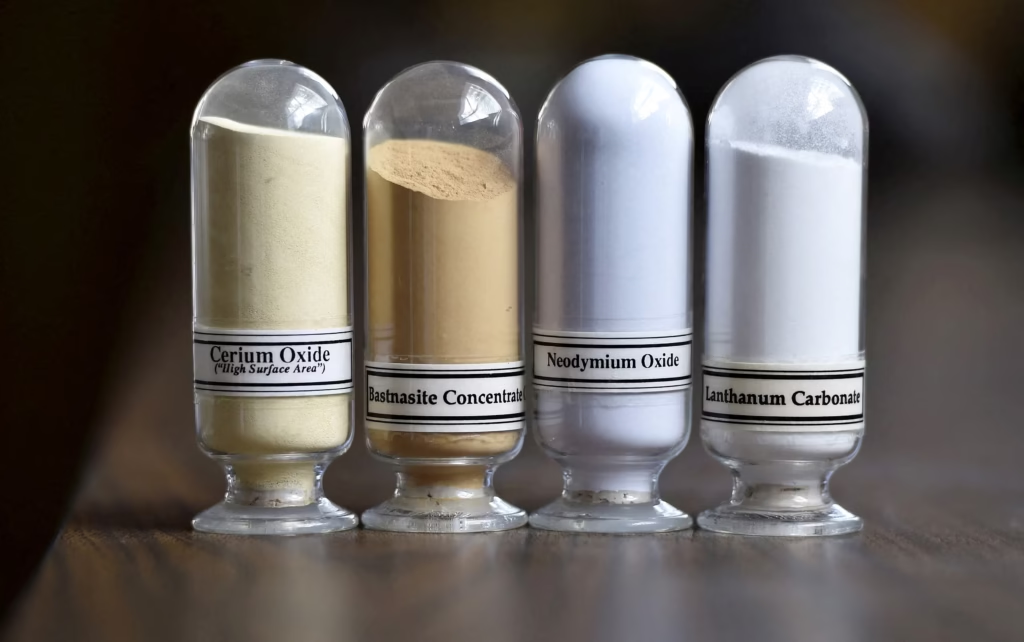What if the future of your electric car, your phone, and even America’s fighter jets… depended on a handful of rare metals mostly controlled by one country?
What if the battle for these elements wasn’t happening in the headlines… but underground, underwater, and sometimes even in abandoned nuclear zones?
This isn’t science fiction.
It’s the very real, very quiet war for rare earths — and it’s about to shape everything.

Table of Contents
Rare Earths 101 – Light vs. Heavy

1. Rare earth elements are divided into two groups: light and heavy.
2. Light rare earths are found in many places around the world. They’re abundant and relatively easy to mine, so supply isn’t a big issue.
3. Heavy rare earths, like dysprosium (Dy), are less common and more critical, especially for high-tech applications.
The Magnet Revolution

4. In 1983, Japanese scientist Masato Sagawa developed a powerful magnet made from neodymium, iron, and boron.
5. By combining two parts neodymium, twelve parts iron, and one part boron, he created the strongest permanent magnet known.
6. This new magnet was over ten times stronger than the ferrite magnets used before.
7. Because these magnets are so strong, they can be made smaller without losing power.
8. Their strength and compact size made them ideal for advanced motors.

9. Electric vehicles, robots, and other devices that rely on electric motors started using these magnets.
10. While industrial motors focus on strength and speed, modern devices like robots need precise control, which these magnets help provide.
Robots and Precision

11. Multi-jointed robots operate in 3D space and perform tasks like gripping, welding, or cutting, requiring high precision.
12. Each robot joint has an actuator (a combination of a motor, gearbox, and encoder). Without small, high-performance motors and precise control, robots can’t move smoothly like humans.
13. Sensors are needed to control tiny motor movements, and actuators must handle various motions, not just simple rotation.

14. Traditionally, robots used sensors and object recognition software to detect items and then moved actuators accordingly.
15. Now, AI learns from motor rotation data, actuator angles, and sensor inputs to control recognition, movement, and motor functions in one algorithm.
16. With continued AI learning, robots could move as naturally and accurately as humans.

The Motor Market and Military Use
17. The motor market is rapidly expanding.
18. Neodymium-iron-boron magnets are essential for improving motor performance.

19. Although developed in Japan, both GM (USA) and Sumitomo Metals (Japan) commercialized these magnets around the same time.
20. Each company used different methods, leading to separate patents.
21. GM’s method allowed for various magnet shapes and sizes with high performance, while Sumitomo’s was simpler and cheaper, suitable for mass production.
22. They agreed to share their technologies through cross-licensing. GM established a subsidiary, Magnequench, in 1986 to commercialize these magnets.
23. Magnequench’s biggest customer was the U.S. Department of Defense, which bought 85% of its Nd-Fe-B magnets.

China’s Strategic Move

24. In 1995, Magnequench was sold to Sextant Group.
25. The real buyer was China’s state-owned San Huan New Materials, under the Chinese Academy of Sciences.
26. After acquiring Magnequench, they started building identical production lines in China.
27. By 2000, they began dismantling Magnequench’s equipment and shipping it to China.

28. By 2003, the U.S. plant closed, workers were laid off, and production moved to China.
29. China had plenty of rare earths but lacked the technology and patents.
30. Owning Magnequench gave China both the technology and patents.
31. By 2010, China produced 75% of the world’s Nd-Fe-B magnets, becoming the top producer.
China’s Rare Earth Strategy

32. Deng Xiaoping once said, “The Middle East has oil; China has rare earths,” highlighting their strategic importance.
33. His daughter, Deng Nan, then a vice minister, led the acquisition of Magnequench.
34. While Deng secured the resources, his daughter obtained the refining technology and patents.
35. With most neodymium magnets made in China, the U.S. faced national security concerns.
36. Each F-35 stealth fighter requires about 920 pounds (417 kg) of Nd-Fe-B magnets.
37. In September 2022, President Biden paused F-35 acquisitions due to the use of Chinese-made magnets.
38. The U.S. couldn’t find alternatives to Chinese Nd-Fe-B magnets.
39. After two months of review, the military had to resume F-35 production using Chinese rare earths.

The Heat Problem and Dysprosium’s Role
40. Nd-Fe-B magnets have a weakness: heat.
41. At high temperatures, their magnetic properties degrade.
42. Generally, they start losing strength above 100°C.
43. This is where dysprosium becomes vital.
44. Adding 1% dysprosium raises the magnet’s heat resistance by about 15°C.
45. High-performance motors often exceed 100°C (212°F.), so without dysprosium, magnets can’t perform well.

Dysprosium: Small But Mighty

46. Strong motors that need to spin fast—like the ones in EVs or power generators—get hot, so they need dysprosium to stay magnetic.
47. That’s why you’ll always find a bit of dysprosium in the magnets used in high-performance motors and EVs.
48. The more high-tech the weapon or device, like the F-35 fighter jet, the more critical dysprosium becomes.
49. Right now, the only real sources of dysprosium being mined are in China and Myanmar.

50. In fact, a big chunk of China’s dysprosium—over 65%—actually comes from Myanmar.
51. China has even supported rebel groups in Myanmar’s mining areas to keep that supply flowing.
52. China also mines dysprosium in its own Jiangxi province.
53. But here’s the catch—dysprosium doesn’t just show up everywhere. It’s only found in certain kinds of sediment-rich areas.
54. Outside of China and Myanmar, the only known land-based dysprosium sources are in Siberia and Greenland.

55. Russia has a deposit called Tomtor, but with so many other natural resources, they haven’t rushed into rare earth development.
56. Meanwhile, resource-rich countries like Australia and the U.S. haven’t found any commercially mineable dysprosium at home.
57. Among Western allies, Greenland is the one place with confirmed deposits that could actually be developed.
58. And yes—when Trump was eyeing Greenland, it wasn’t just about Arctic strategy—dysprosium was part of the plan.
59. Greenland holds around 44% of the world’s known heavy rare earth reserves. That’s a magnet-making jackpot.
Greenland’s Goldmine… or Earthmine

60. Two key mines in Greenland lead the pack: Kvanefjeld and Tanbreez.
61. Kvanefjeld, in the south, is massive—it holds over 1.1 billion tons of rare earths, uranium, zinc, and more.
62. Tanbreez is smaller—about 440 million tons—but it’s loaded with heavy rare earths like dysprosium and terbium.
63. Kvanefjeld was being developed by a company called Greenland Minerals.
64. While the company is Australian, its largest investor is a Chinese firm—so, yeah, China again.

65. If the ruling party had stayed in power in Greenland, the mine would’ve likely moved forward—with China at the helm.
66. But after the opposition party won the election, plans to develop Kvanefjeld were put on hold.
67. China wasn’t happy and launched a legal challenge, but it’s not going smoothly.
68. eanwhile, the Tanbreez mine was scooped up by a U.S. mining company called Critical Metals.
69. About 1,000 tons of dysprosium are produced globally each year. Tanbreez alone has 7.6 million tons in the ground.
70. And the best part? Tanbreez already has the green light to start mining, so production could begin soon.

Digging Deep… Without Killing the Planet
71. But there’s a catch (again): environmental damage.
72. Mining dysprosium is messy—it causes serious pollution, especially during the refining process.

73. Greenland only has about 50,000 residents, so local human impact might seem small. But pollution is still a big concern.
74. So, what can the U.S. do?
75. Here’s one idea: find dysprosium-rich sediment layers…
76. …on the ocean floor. Yep, underwater mining.
77. The Pacific seabed has clay layers full of dysprosium and other rare earths.
78. Land-based rare earths are formed through volcanic activity and often come with radioactive elements like thorium and uranium.
79. That’s bad news for people and the environment—those leftovers are toxic.
80. But seafloor rare earths are different.

81. Underwater volcanoes release hot, iron-rich water that reacts with seawater and traps rare earths.
82. Over thousands of years, that builds up like a bathtub ring—except it’s full of valuable metals, not soap scum.
83. And the best part? Seafloor rare earths don’t contain radioactive elements.
84. So if you haul up this seabed mud, you can process it without worrying about toxic waste.
85. That makes undersea mining a cleaner, safer option for the rare earth race.
Japan, Deep Sea Dreams, and a Chernobyl Twist

86. Japan already discovered a massive dysprosium deposit in its exclusive economic zone back in 2012.
87. Near Minamitorishima Island, they found enough rare earths to last the entire planet over 700 years.
88. So what’s the holdup? Cost and cleanup.
89. It’s still cheaper to import rare earths from China, and even underwater mining can create pollution.
90. That’s why Japan postponed full development until 2028—and in the meantime, they’re building up reserves.

91. Meanwhile, Trump isn’t waiting around.
92. He floated the idea of signing an executive order to allow deep-sea mining.
93. The U.S. has found similar rare earth hotspots under the ocean—but most are in international waters.
94. Problem is, international law (UNCLOS) bans commercial mining in global waters. Even exploration requires permission from the International Seabed Authority (ISA).
95. Trump proposed a workaround: having NOAA (the U.S. ocean agency) issue permits directly, skipping the UN.
96. This idea gained traction after mining company TMC lobbied the White House.
97. Even if we get the stuff from the deep sea, refining it is still a problem.

98. One surprising option on the table: refine it in Ukraine.
99. Why Ukraine? Because they have land no one’s using…
100. …specifically, the Chernobyl exclusion zone—abandoned since the nuclear disaster. It’s isolated, already contaminated, and might just be the perfect place for a no-fuss refining site.
“It’s Not Just Rare — It’s Dysprosium, Dummy.”

If you’re watching China’s rare earth export restrictions and only focusing on neodymium, you’re missing the real magnet in the room. Light rare earths? They’re everywhere — even the U.S. has some in the ground. But heavy rare earths like dysprosium. That’s the real choke point. Few places have it. Fewer can refine it without wrecking the environment. China knows it — and owns it.
That’s why global attention is shifting to places like Greenland’s untouched mines and the ocean floor’s muddy treasure chests.
But here’s the twist: even if we dig it up, the question becomes — where do we refine it? One surprising answer? Ukraine. Yes, seriously. The abandoned Chernobyl zone may soon become the quiet frontline of the rare earth refining game.
Bottom line: You can’t understand this rare earth power play without putting dysprosium front and center.
The future of defense, energy, and tech might just hinge on a metal most people can’t even pronounce.
Discover more from Alphazen Dynamics
Subscribe to get the latest posts sent to your email.



